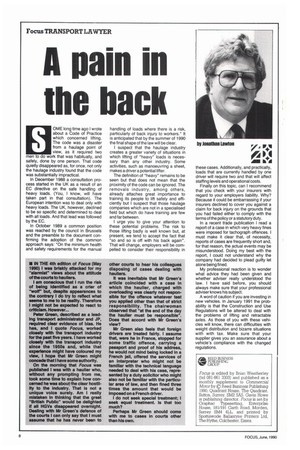A pain in the back
Page 10

If you've noticed an error in this article please click here to report it so we can fix it.
OME long time ago I wrote about a Code of Practice which concerned lifting. The code was a disaster from a haulage point of view, as it required two men to do work that was habitually, and safely, done by one person. That code quietly disappeared as, for once. not only the haulage industry found that the code was substantially impractical.
In December 1988 a consultation process started in the UK as a result of an EC directive on the sale handling of heavy loads. (You. I know, will have taken part in that consultation). The European intention was to deal only with heavy loads. The UK. however, declined to be so specific and determined to deal with all loads. And that lead was followed by the EC.
In October 1989 a common position was reached by the council in Brussels and the preamble to the document confirming the adoption of the common approach says: "On the minimum health and safety requirements for the manual handling of loads where there is a risk, particularly of back injury to workers." It is anticipated that by the summer of 1990 the final shape of the law will be clear.
I suspect that the haulage industry creates a greater variety at situations in which lifting of "heavy" loads is necessary than any other industry. Some activities, such as manoeuvring a sheet, makes a driver a potential lifter.
The definition of "heavy" remains to be seen but that does not mean that the proximity of the code can be ignored. The removals industry, among others, already attaches great importance to training its people to lift safely and efficiently but I suspect that those haulage companies which are not in a specialised field but which do have training are few and tar between.
I urge you to give your attention to these potential problems. The risk to those lifting badly is well known but, at present, we tend to accept the fact that "so and so is off with his back again". That will change, employers will be compelled to consider their responsibility in these cases. Additionally, and practically, loads that are currently handled by one driver will require two and that will affect staffing levels and operational costs.
Finally on this topic, can I recommend that you check with your insurers with regard to your employers liability. Why? Because it could be embarrassing if your insurers declined to cover you against a claim for back injury on the grounds that you had tailed either to comply with the terms of the policy or a statutory duty.
In a recent trade publication I read a report of a case in which very heavy fines were imposed for tachograph offences. I must make it clear that, of necessity, reports of cases are frequently short and, for that reason, the actual events may be misunderstood. Doing my best with the report I could not understand why the company had decided to plead guilty let alone being fined.
My professional reaction is to wonder what advice they had been given and whether adviser really understood the law. I have said before, you should always make sure that your professional adviser knows his subject.
A word of caution if you are investing in new vehicles. In January 1991 the probability is that the Construction and Use Regulations will be altered to deal with the problems of lifting and retractable axles. As those of you with these vehicles will know, there can difficulties with weight distribution and bizarre situations with with tax. Make sure that your supplier gives you an assurance about a vehicle's compliance with the changed regulations.




















































































































